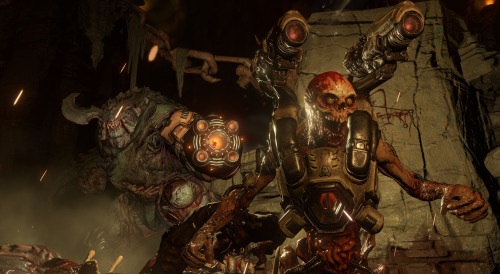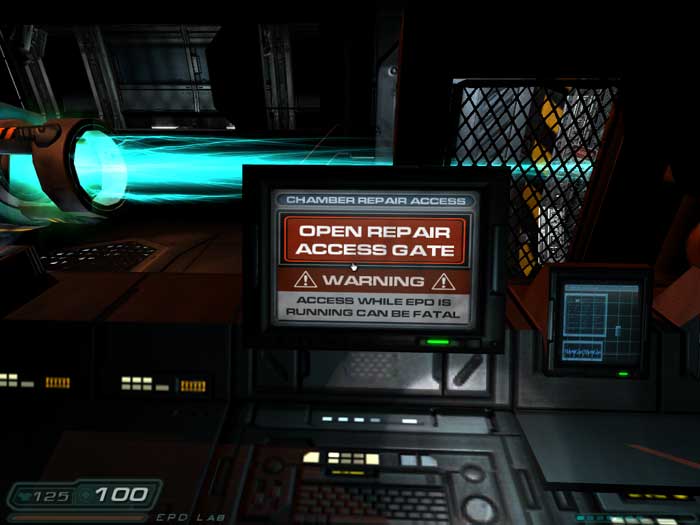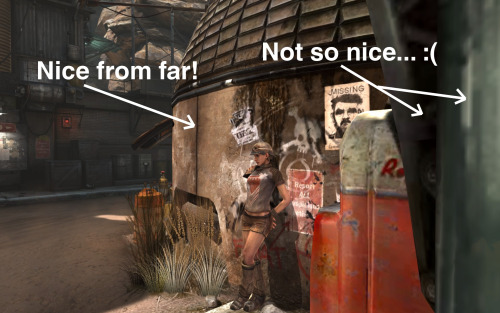DOOM, idTech and MegaTextures
By benjo_t 16 Comments

We recently had our first glimpse of the newest entry in the long-lived Doom series, styled simply as DOOM, at this year’s E3 conference. First for most of us, anyway, as id did in fact show the game to an audience at QuakeCon in 2014, though this footage was kept behind closed doors - a troublesome but not unheard-of marketing technique in which the majority of gamers are denied a chance to actually see the game, the hope being that the subsequent hyperbolic testimonies of those few who did actually see it will drive a ravenous fandom into hype-fuelled frenzy, all without any actual footage on which to assess the thing.
Nevertheless, we eventually got to see a decent chunk of what id is happy to confirm is actual game-play, replete with that special brand of DOOM shotgun worship, a reunion of the classic cast of demonic hooligans all prettied up in high definition and a stack of grizzly first-person finishing moves, a first for the series if you don’t count Brutal Doom, which saw jaws torn asunder and demonic faces bashed repeatedly into pulpy satanic burger to the whooping and general satisfaction of the crowd. It has to be said that the game looks fun, if still a way off from the frantic pace of the strafe-jumping, 43-mile-per-hour-running original.
Fan reaction seems warm, if somewhat perturbed by certain aesthetic elements such as a colour filter some would rather see removed, in a sentiment that recalls reactions to Deus Ex: Human Revolution, another modern take on a well-established classic which, lingering colour-filter complaints aside, did very well in approximating a modernised experience of the game it rebooted. If DOOM can match Human Revolution in that regard I think we just might all be content.
Thinking about it, negativity toward colour palette decisions in games seems to be something of a recurring reaction - I remember many altered pictures of Diablo III doing the rounds before its release as part of a wave of opinion that the game simply wasn’t dark enough. I think, generally, there’s an argument to be made for trusting the artistic principles of the people whose job it is to beautify our games, but even so, the fidelity of the “fixed” examples of these games is surprisingly appealing. Perhaps id has been too quick to wash its environments and character models in a wave of greeny yellow, dulling the otherwise appealing vibrancy of its monstrous demons and over-softening instances of potentially visually interesting contrast. It’s hard to say; I’m no game artist. Yet while I’m happy to sit on the fence of colour-washing for now, there is one thing I really do hope they remove: MegaTextures.
What’s a MegaTexture? In short, it’s a method of retrieving game textures that revolves around the use of a single, huge texture instead of using lots of repeated smaller textures. You can read more about it on an informative Reddit thread here, or over on Wikipedia.
The idea is that by using an extremely large texture, which is compressed and streamed in and out of video memory as required, we can have game worlds that don’t rely on tiling the same small textures over and over - in theory, every patch of the game’s world is visually unique. It’s a cool idea, but in practise I consider it to have seriously negatively impacted id Software’s latest games.
If you’ve ever played RAGE or Wolfenstein: The New Order, you probably noticed that the games suffer from an extraordinary level of texture pop-in. Particularly on consoles, where hard drive speeds are slower, merely turning around on the spot results in textures slowly loading in, creating a blurry and distracting experience. The games might be forgiven for this if the MegaTexture technique resulted in especially beautifully rendered textures, but the fact is that the giant MegaTexture is so heavily compressed due to storage concerns that even a cursory glance reveals horribly low resolution and messy, indistinct textures. Further, it’s hard to even appreciate the ostensible benefit of a truly visually unique world. Turns out that in RAGE, one patch of sand tends to look like any other. Whether a particular texture is repeated or not throughout a level that is comprised of more than its textures is just not something I tend to notice, and games are already adept at disguising the use of tiled textures in ways that make repeating art assets a non-issue.
It’s not an exaggeration to say that in some instances Doom 3 has clearer, more legible textures, particularly when text is involved, than the games that succeeded it. And it does so without having to distractingly stream textures in and out. The practical cons of MegaTextures simply outweigh the conceptual “coolness” of knowing a texture isn’t repeated for me. I ended up unable to finishWolfenstein, despite feeling it was an excellent shooter, so distracting was the popping and over-sharpened, low resolution texture work on display. The painful thing is that it’s obvious much work was poured into the source texture - it’s the compression that killed the quality, laying waste to artists’ meticulous work in the process.
I’ve pulled some examples off the web to try and illustrate what I mean:


I have a huge amount of respect for John Carmack, who is a genius-level programmer and instrumental figure in the industry. His personal interest in games development and engine programming have contributed to gaming in a way that cannot be understated. Yet, it’s probably that very passion which led to the inclusion of a feature that simply wasn’t feasible to pull off in the hardware generation it was targeted for - a concession Carmack himself made when DOOMwas revealed.
It’s hard not to be charmed by Carmack’s passion-project approach to his engine - he clearly just wanted to implement an awesome, technically impressive feature - but I find myself convinced it was to the detriment of the games as a whole. Carmack’s passion for development meant he envisioned a feature that was technically interesting, but practically infeasible. A fun project for him to devote time to, but one that arguably solved a problem no one was having. I’m not a game developer: I have little understanding of the complexities that make game graphics tick. All I can say is that as a player, the tech made the games look worse and perform worse, for zero trade off in visual competence. In fact, the games looked relatively worse than their predecessors.
As we know, Carmack moved on to Oculus VR where he will doubtlessly drive innovation, rising to the complex technical challenges that so clearly drive his passion for development.
With his departure, and the hiring of Tiago Sousa (R&D Principal Graphics engineer of Crytek) I’m left to wonder how MegaTextures will be handled going forward. I’m not opposed to its inclusion if it works this time around. Part of me thinks that it must have been very hard to say no to feature ideas of the creator of Doom, and that mega-texturing might quietly slip out of whatever version of idTech powers id Software’s next games - left out as the interesting, doubtlessly prescient, but ultimately flawed experiment of the legendary developer.

Log in to comment